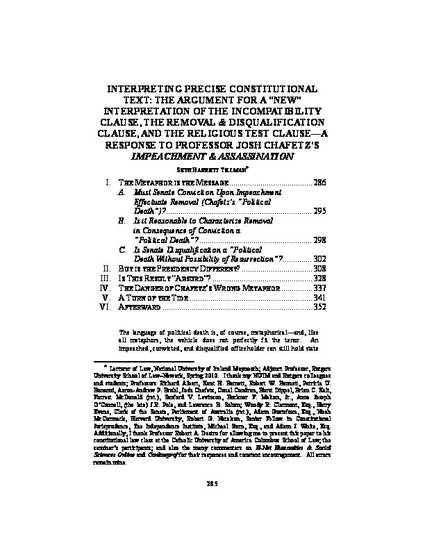
This article is a response to Professor Josh Chafetz's Impeachment & Assassination, 95 Minn. L. Rev. 347 (2010).
This Article is a textual exploration of the Constitution’s varying usage in regard to office and officer. The Constitution uses a variety of phrases relating to office and officer, including: (A) Officer of the United States; (B) Office under the United States; (C) Office under the Authority of the United States; and (D) Officer (unmodified). The consensus position – as put forward by Professors Akhil R. Amar and Vikram D. Amar in 1995 – is that the Constitution’s varying terminology in regard to office and officer is without any meaningful distinction. This Article takes a contrary position. Officer of the United States is the most restricted of the categories listed above; Officer of the United States embraces only appointed officers in the Executive and Judicial Branches. Category (B) is wider than (A), category (C) is wider than (B), and category (D) Officer (unmodified) is the most expansive of the categories. Indeed, category (D) embraces elected officials, not merely appointed officers.
If this text-sensitive framework is correct, then much of the originalist scholarship written since 1995, when the Amars put forward the current consensus position, must be abandoned, or, at least, closely reviewed. One such paper is Professor Chafetz’s Impeachment and Assassination, an influential 2010 publication. This Article critiques Chafetz’s article, conclusions, and his historical approach. And, it further shows how Professor Chafetz’s embracing the consensus position puts in motion a train of errors leading him far afield from the original public meaning of the Constitution’s impeachment-related provisions.
Furthermore, if this new view is correct, then our modern understanding of constitutional provisions using office- and officer-laden language is inconsistent with the original public meaning of those clauses. Thus, in addition to the Impeachment Clause, the new view destabilizes our current understanding of the Succession Clause, the Religious Test Clause, the Incompatibility Clause, and the Removal and Disqualification Clause.
This paper is largely a response to Professor Chafetz’s Minnesota Law Review publication. But it also responds to several recent publications by Professors Steven G. Calabresi (in PENNumbra) and Saikrishna B. Prakash (in the Duke Journal of Constitutional Law and Public Policy), and to a student note by Mr. David J. Shaw (in the Georgetown Law Journal).
See Seth Barrett Tillman, Interpreting Precise Constitutional Text: The Argument for a “New” Interpretation of the Incompatibility Clause, the Removal & Disqualification Clause, and the Religious Test Clause–A Response to Professor Josh Chafetz’s Impeachment & Assassination, 61 Cleveland St. L. Rev. 285-356 (2013), available at papers.ssrn.com/abstract=1622441, also available at http://works.bepress.com/seth_barrett_tillman/164/.
[first posted October 11, 2010]
[revised August 27, 2013]
